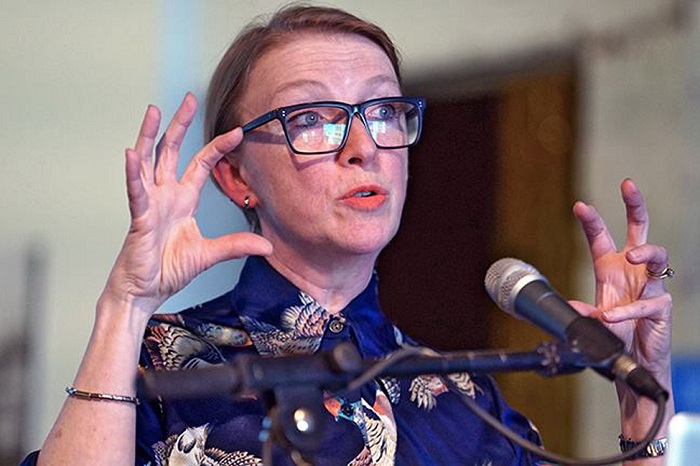Two Northern Soul dancers are seen dancing with passion in the empty, once splendid Boardroom at the now disused Spode Factory, Stoke-on-Trent, leading to collisions of meaning, not least the questioning of the sanctity of the Boardroom, a place where traditionally the Managing Director and the Board would entertain buyers and guests. In the film, the room is transformed into a ballroom, a dance hall, where uplifting music is played and a couple dances, absorbed in their own movements and thoughts.
Through this film and it’s installation as part of the British Ceramics Biennial in the Managing Director’s office at the Spode Factory issues such as the class system, labour and norms of behavior are questioned. Notions of the industrial ruin in combination with the Stoke’s prominence within the history of the Northern Soul movement are explored through the film making connections between Stoke and Detroit (from where the music largely originates). The work articulates with contemporary questions around site, dance and music as a way of addressing emotional responses to particular places, and reference Jacques Derrida’s ideas of Hauntology, Phil Collins’ ‘They Shoot Horses’ 2004, Ian Breakwell’s ‘The Other Side’, 2002 and the project by electronic musician The Caretaker (James Kirby) inspired by the haunted ballroom scene in Kubrick’s The Shining, 1980.
The Archive of Extinction 2011
Text reads
The Extinction Archive
Oaks Water Tower, Gleadless, Sheffield
The interior of the water tower is a large voluminous space. Placed in the centre of this space is a soaring black eight-sided object. It is shiny and cold to the touch, perhaps made of black marble or granite. This octagonal column is almost the height of the internal area of the water tower and imitates its form. On the eight sides of the structure are hundreds of little white, porcelain buttons. Names are written on each of the buttons, both a scientific name and a common name. Also written is the date of the animal’s extinction (e.g. Equus Quagga Quagga/ Quagga/ 12th August 1883). The buttons are distributed evenly from the base of the object to just above head height, the empty black surface above awaiting further buttons. In the future a platform that can be raised and lowered will have to be added in order to gain access to the higher buttons. Pressing a button releases the sound of an extinct animal into the inner chamber of the water tower via a number of Tannoy speakers placed on top of the octagonal structure. Transmitters mounted on top
of the water tower simultaneously broadcast the sound of the animal into the atmosphere as digital sound waves. Pressing many buttons at the same time results in a cacophony of extinct voices echoing and running into one another inside the tower and into the air outside, as silent coded messages.
A Heap of Extinction (after Robert Smithson): containing the names of 707 animal species and 16 animal subspecies documented as extinct since the year 1500. This figure is wildly inaccurate, the true figure probably being much greater.
Chloë Brown’s drawing The Extinction Archive was included in the publication Brutalist Speculations and Flights of Fancy, published by Site Gallery, 2011, ISBN: 978 1 899926 18 3
This publication considers six of Sheffield’s Brutalist buildings and explores the place that these buildings hold in the city today. Twenty-five artists and writers from London, Sheffield and Berlin were invited to contribute. Three notable writers on the urban landscape and architecture give a historical and social context and speculations of their own. Project conceived by Julie Westerman.
Artists
Christl Mudrak, Dominique Hurth, Olivia Reynolds with Jon Moscow, Ines Lechleitner, Irene Pätzug , Oliver Zwink, Valentin Hertweck, Peter Klare, Stephan Hüsch, Michelle Atherton, Chloë Brown, Matthew Harrison, Jaspar Joseph-Lester, Sharon Kivland, T C McCormack, Penny McCarthy, Becky Shaw, Gary Simmonds, Hester Reeve, Andrew Sneddon and Julie Westerman.
Writers
Owen Hatherley, Professor Steve Pile and Professor Jane Rendell.
Rec 16 (2011)
The film Rec.16 and the watercolour studies Vanishing Point, show views of the tombs on Isola di San Michele, the island which Venice designates as it’s cemetery. These tombs appear as architectural storage systems, reminiscent of archiving systems, for human remains. The grid-like formation of the blocks of tombs repeat and create a complex series of vanishing points, which form the central theme of both the film and the watercolour studies. This work is part of an ongoing interest into the idea of Memento Mori. This work was shown in Isola di San Michele, and exhibition by Elisabeth Wörndl and Chloë Brown, Basement Gallery,Vienna, Austria, 2011.



